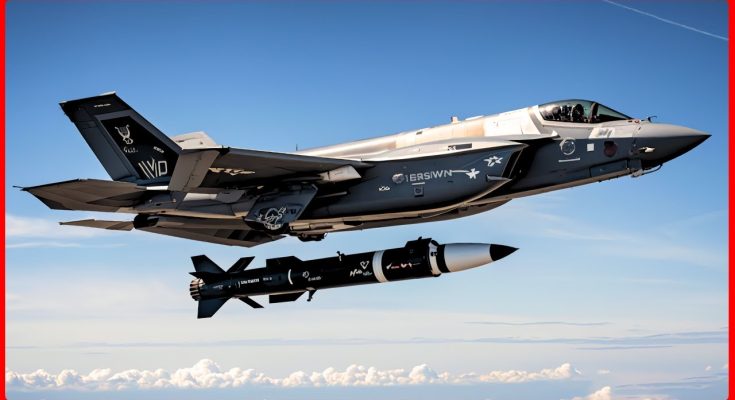In 2025, the F-35 Stealth Fighter—already known for its unparalleled versatility, cutting-edge stealth technology, and advanced capabilities—has taken on an unexpected role: becoming one of the most feared nuclear bombers in modern warfare. The F-35, initially designed as a multi-role stealth fighter for air superiority, strike missions, and close air support, has been significantly upgraded to deliver nuclear payloads, marking a game-changing evolution for the aircraft. This shift positions the F-35 as a strategic asset capable of deterrence, precision strike, and extended reach, all while maintaining its legendary stealth and maneuverability.
The Transformation into a Nuclear Bomber
The core of the F-35’s transformation into a nuclear bomber lies in its ability to carry and deliver nuclear warheads with precision. Although the F-35 was originally built for tactical and conventional roles, it was designed with the flexibility to evolve in response to shifting military needs. This adaptability now includes the integration of nuclear weapons into its payload capacity, alongside conventional munitions.
The new nuclear configuration of the F-35 includes modifications to its internal weapons bays, allowing it to carry a variety of nuclear bombs and precision-guided munitions. One of the key upgrades is the ability to carry the B61-12 nuclear bomb, a more advanced, precision-guided weapon that provides greater flexibility and accuracy compared to previous models. This means that the F-35 can now perform dual roles as both a tactical strike fighter and a strategic nuclear delivery platform, making it a more formidable weapon in the U.S. nuclear arsenal.
Unmatched Stealth and Survivability
What makes the F-35 especially dangerous as a nuclear bomber is its stealth capabilities. The aircraft’s advanced low-observable design—optimized for evading detection by radar and infrared sensors—allows it to operate in highly contested airspace with reduced risk of being detected by enemy air defense systems. This stealth ability is particularly critical when performing nuclear strikes, as it ensures that the F-35 can approach its target without giving adversaries enough time to intercept or retaliate.
Furthermore, the F-35’s sensor fusion capabilities enable it to gather real-time intelligence and adapt to rapidly changing battlefield conditions. These features allow the aircraft to deliver nuclear payloads with precision, targeting specific assets with minimal collateral damage. This level of accuracy is particularly valuable for maintaining global stability and ensuring that nuclear weapons can be used as a last-resort deterrent rather than indiscriminate force.
Enhanced Range and Precision Strike
One of the major advantages of the F-35 as a nuclear bomber is its extended range and ability to perform precision strikes. The aircraft’s advanced engines and aerial refueling capabilities ensure that it can strike targets deep within enemy territory, making it an ideal platform for strategic nuclear deterrence.
In addition to its range, the F-35’s precision targeting systems allow it to deliver nuclear payloads with exceptional accuracy. This precision reduces the risk of miscalculation, ensuring that targeted strikes achieve their intended effects with minimal impact on civilian infrastructure and collateral damage. With this level of control, the F-35 provides a strategic advantage in a potential nuclear conflict—capable of hitting high-value targets such as military bases, command centers, or enemy nuclear assets with exacting precision.
Multi-Domain Operations and Global Reach
The integration of nuclear strike capabilities into the F-35 enhances its role in multi-domain operations, a critical aspect of modern warfare. The F-35’s ability to operate in conjunction with other U.S. assets, including bombers, tankers, drones, and satellites, creates a comprehensive network that allows for coordinated, real-time operations. This synergy enhances the F-35’s global reach, enabling it to be rapidly deployed and operate in virtually any theater of conflict.
The F-35’s role in nuclear deterrence is not limited to direct strikes alone. Its networked capabilities enable it to relay intelligence, conduct electronic warfare, and provide command and control in high-threat environments, adding an additional layer of flexibility to its nuclear role. This allows for a wide range of strategic options, ensuring that the U.S. can maintain a flexible and credible nuclear deterrent across multiple domains.
Global Impact and Strategic Deterrence
The F-35’s new role as a nuclear bomber significantly impacts the global balance of power. As more nations develop and refine their nuclear arsenals, the U.S. Air Force continues to adapt its approach to nuclear deterrence, with the F-35 representing the future of strategic defense. With its combination of stealth, precision, and multi-role versatility, the F-35 adds a new layer of deterrence capability to the U.S. military arsenal.
Adversaries like Russia and China, both of whom are investing heavily in modernizing their own nuclear forces, must now factor the F-35’s nuclear strike capabilities into their strategic calculations. The aircraft’s ability to operate undetected, strike deep into enemy territory, and deliver nuclear payloads with unparalleled accuracy ensures that the F-35 will play a key role in maintaining nuclear deterrence and stability on a global scale.
Conclusion
The F-35 Stealth Fighter’s evolution into a nuclear bomber has revolutionized the aircraft’s role within the U.S. Air Force, transforming it from a versatile multi-role fighter into one of the most feared and capable nuclear delivery platforms in existence. With its advanced stealth, extended range, precision targeting, and adaptability, the F-35 is now an integral component of the U.S. nuclear arsenal, ensuring that it remains a dominant force in global deterrence strategies. The world now faces a new paradigm in nuclear warfare, one in which the F-35 stands as a symbol of advanced military power, offering unmatched flexibility and power in the event of nuclear conflict.



